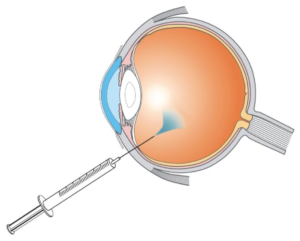What are intravitreal injections?
Intravitreal injections are injections of medicine that stops leakage, growth and bleeding from abnormal blood vessels in the retina. These injections target the protein (VEGF) that creates growth of new blood vessels which also makes them leak. People with retinal diseases such as diabetic retinopathy, wet macular degeneration, retinal vein occlusion are candidates for anti-VEGF injections as these diseases form leaky abnormal blood vessels that cause swelling in the macula/retina. The use of intravitreal injections reduce the swelling in the retina in order to preserve as much vision as possible as most patients experience vision loss due to the damage created by these abnormal blood vessels.
What to expect?
When patients come in for treatment, they will have their vision tested, their intraocular pressure taken and their eye will be dilated. After a series of diagnostic tests have been performed, an experienced technician will escort the patient into an exam room where they will begin preparation for the injection. A numbing solution will be placed on their eye to anesthetize the surface of the eye and an antiseptic solution will be followed to reduce the chance of infection. The doctor will then further anesthetize your eye by giving the patient a lidocaine injection to completely numb the eye (takes 7-10 minutes to take effect). Once ready, the doctor will take a sterile instrument to hold the eye open followed by sterilizing the area of the injection site. He will then inject the medication through the sclera and into the vitreous. This process takes less than one minute. Following injections, patients can experience discomfort from the antiseptic solution used during the injection which is expected. Patients are advised to use frequent artificial tears or warm compresses in order to help soothe the eye. If patients experience soreness or pain, it is advised to take Tylenol. However, if the discomfort or pain lasts more than a day or if patients notice a decline/sudden loss in vision, it is best to contact the doctor for examination in order to rule out any corneal abrasion, infection, or increase in intraocular pressure.

